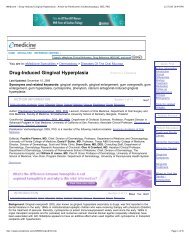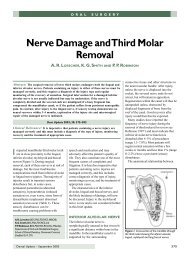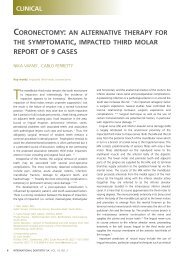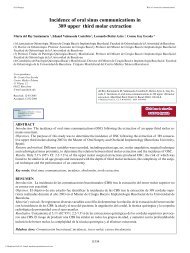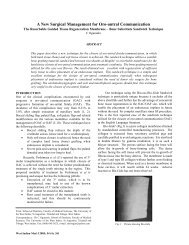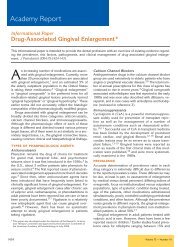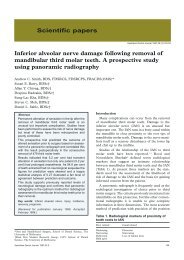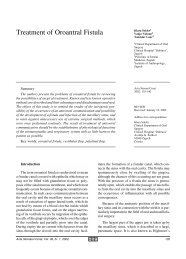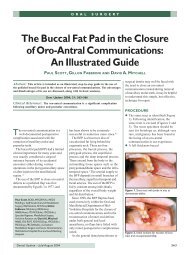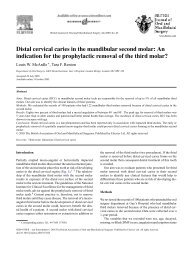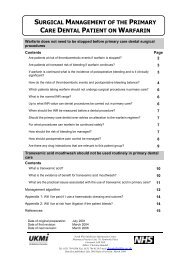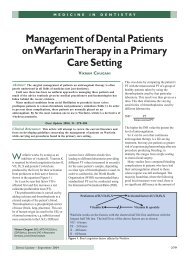Oral Surg Oral Med Oral Pathol Oral Radiol Endod 2004 - Surgical ...
Oral Surg Oral Med Oral Pathol Oral Radiol Endod 2004 - Surgical ...
Oral Surg Oral Med Oral Pathol Oral Radiol Endod 2004 - Surgical ...
Create successful ePaper yourself
Turn your PDF publications into a flip-book with our unique Google optimized e-Paper software.
ORAL SURGERY ORAL MEDICINE ORAL PATHOLOGY<br />
Volume 97, Number 1<br />
Table V. Effects of long-standing xerostomia 88-90<br />
Increased frequency of caries (particularly cervical caries)<br />
Proclivity toward acute gingivitis<br />
Dysarthria<br />
Dysphagia<br />
Dysgeusia<br />
Proclivity toward candidal infection (eg, acute pseudomembranous<br />
candidiasis, median rhomboid glossitis, denture-associated<br />
stomatitis, angular cheilitis)<br />
Burning tongue/depapillation of tongue<br />
<strong>Oral</strong> mucosal soreness<br />
Dry, sore, cracked lips<br />
Salivary gland enlargement (various causes)<br />
that individuals infected with HCV have a predominance<br />
of CD20-positive cells. 58 HCV infection may<br />
occasionally give rise to non-Hodgkin’s lymphoma and<br />
salivary disease akin to that of SS, but there is no real<br />
evidence to suggest that SS is related to HCV infection.<br />
59<br />
Other viruses. Other viruses such as Epstein-<br />
Barr 60-62 have been implicated in xerostomia. A link<br />
with xerostomia and human T-lymphotropic virus 1<br />
infection has also been found. 63,64 The incidence of<br />
hepatitis B, E, and G virus markers in patients with SS<br />
has been reported to be higher than that of healthy<br />
subjects, 65 but it seems unlikely that this is of any<br />
etiologic significance.<br />
Other causes of xerostomia. Primary biliary cirrhosis,<br />
66 cystic fibrosis, 67 and diabetes mellitus 68-79 rarely<br />
cause xerostomia, as do salivary gland agenesis, 80 with or<br />
without ectodermal dysplasia 81 ; triple-A syndrome 82 ;<br />
amyloidosis 83,84 ; and hemochromatosis. 85,86<br />
CLINICAL CONSEQUENCES OF XEROSTOMIA<br />
The clinical consequences of long-standing xerostomia<br />
are summarized in Table V. Xerostomia is unpleasant<br />
and, if prolonged, can lead to a reduced quality of<br />
life. 87-90<br />
The xerostomia of SS can be particularly troublesome,<br />
giving rise to dysarthria and dysphagia. Quality-of-life<br />
assessments have been used in some studies<br />
to evaluate the effects of xerostomia in patients<br />
with primary SS, wherein those with xerostomia<br />
have been shown to have a reduced quality of life<br />
compared with healthy persons. 91-93 However, studies<br />
incorporating a larger sample size are required to<br />
confirm these findings and a disease-specific measure<br />
is required to assess the impact of SS on healthrelated<br />
quality of life. 93<br />
INVESTIGATIONS OF PROLONGED<br />
XEROSTOMIA<br />
The investigation of xerostomia centers upon a<br />
series of clinical, radiologic, and laboratory-based<br />
Porter, Scully, and Hegarty 33<br />
tests. Much can be elicited from the history and<br />
clinical examination alone, and on the basis of these<br />
and a knowledge of the possible causes of xerostomia,<br />
certain specific investigations can be undertaken<br />
to confirm the working diagnosis. The investigations<br />
can be grouped under the following headings: hematology,<br />
biochemistry, immunology, imaging, histology,<br />
and others (Table VI).<br />
MANAGEMENT OF PROLONGED<br />
XEROSTOMIA<br />
Assessments of available therapies of xerostomia<br />
has been difficult partly because of a lack of welldesigned<br />
randomized, controlled clinical trials and<br />
partly because of disagreement until recently 35 over<br />
diagnostic criteria for such disorders as SS. Clinical<br />
trials of new therapies in disorders such as rheumatoid<br />
arthritis and SLE have been advanced by the<br />
development of internationally agreed-on assessment<br />
and outcome measures such as the American College<br />
of Rheumatology/European League Against Rheumatism<br />
core datasets of disease activity in rheumatoid<br />
arthritis and measures of activity and damage in<br />
SLE such as the British Isles Lupus Assessment<br />
Group, SLE Disease Activity Index, and SLE International<br />
Collaborating Clinics. No such equivalent<br />
consensus exists for SS or any other disorder giving<br />
rise to prolonged xerostomia, and, as a result, clinical<br />
trials have all used different, unvalidated, ad hoc<br />
measures of disease assessment and outcome. One<br />
attempt to bring a coherent approach to this issue is<br />
the “Copenhagen model,” or disease assessment<br />
wheel, that places each disease manifestation within<br />
specific categories depending on their presumed<br />
pathogenesis.<br />
Attempts have also been made to develop this into<br />
a severity tool by grading specific manifestations<br />
according to severity. In March 2000, interested specialists<br />
from around Europe met to develop a consensus<br />
on the broad principles underpinning disease<br />
assessment in SS (particularly primary SS). 34 It was<br />
agreed to adopt the international approach of dividing<br />
assessment into exocrine and nonexocrine disease<br />
activity (potentially reversible and including<br />
sicca symptoms and objective measures and systemic<br />
symptoms particularly fatigue and clinical features),<br />
damage (present for more than 6 months), healthrelated<br />
and generic quality of life, and standard approaches<br />
to adverse events/toxicity and health economic<br />
aspects. The workshop also began the process<br />
of developing specific measures of sicca symptoms,<br />
and systemic activity and damage. To convert this<br />
approach into detailed, experimentally validated assessment<br />
tools, a UK-based collaboration has fo-




